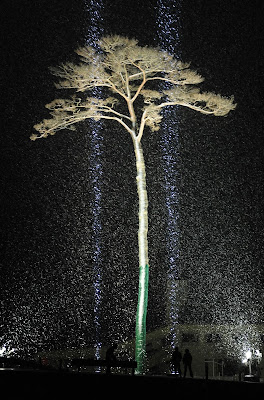Japanese Peace Movements #11: The Miracle Tree
On my trip to Tohoku, the Popoki Peace project visited
several towns that were affected by the tsunami. In each there were markers of
the tragedy, stories of survival and also worries about what the future might
bring. Along the roads, each town would have a markers identifying the point at
which you were entering the tsunami inundation area and exiting it. Because of
this, even if towns and roads are rebuilt, you can still imagine how far the
waters and the destruction reached as you drive up the coast. Each town also
had markers on street corners, on the side of buildings, power poles and street
lights indicating how far away that point was far high ground where someone
might be safe from a future tsunami.
Each town has markers not only of the destruction, but also
of their survival and their endurance. They are usually remnants of life
before. A building that did not fall. A
particular survivor with a powerful tale to tell. In Rikuzentakata, there was a
tree. Around the town it was referred to as different things, but most of them
circled around it being “the miracle tree of hope.”
The coastal plain in Rikuzentakata was once covered with
some 70,000 pine trees, all planted as a deterrent from tsunamis. On the
afternoon of March 11, 2011 when the waves hit, the trees didn’t provide much
resistance or protection from the waves which were close to 50 feet high. The
waves plowed down the trees as well as most buildings in the area killing an
estimated 1,7000 people.
After the waters have
receded though, amidst the rubble and ruins, the residents were surprised and
overjoyed to find a single tree still standing. It became a symbol of the town
and rebuilding. In a small museum near the tree, right in the center of a construction
area, the tree was featured in posters and brochures. This wasn’t a museum
meant for the tree per se, but a place to describe the scope of the destruction
from the tsunami and the plans by the local and national government to clean
things up and keep the community safe.
It was a museum designed to show the Japanese people that
their government is taking care of things and spending their money wisely. Nearby
there was a small store that featured all sorts of tree related souvenirs.
There were postcards, posters, t-shirts, bags, even gloves and socks which
prominently featured images of the trees. Once a new sea wall is built and the
ground level raised, a memorial park will be built in the area.
After seeing so much of this tree in pictures and souvenirs
I was eager to see it with my own eyes. The tree, the museum and the gift shop
are all located in the center of a huge construction area. As we drove into the
middle of it, I felt as if we had entered some other dimension. Massive
machinery, towering conveyer belts and behemoth like earth-moving equipment
surrounded us in a steel city. They stretched out across the landscape giving
the impression of a steel spider web. Behind the trucks, the walls, the gates,
the mountains of dirt, far in the distance along the shore I caught a glimpse
the miracle tree. The reconstruction obscured it, but I could still make out
its outline against the hazy overcast sky.
This wasn’t the real tree mind you. The real tree did
survive the tsunami but died from its roots being exposed to too much salt
water. It was preserved however, with a metal skeleton being inserted into its
trunks and artificial branches and leaves attached. In June 2013 the "enhanced" tree was
returned to its original location, standing watch over the shoreline. Providing both hope for the rebuilding efforts and safety against future disasters.
As much as I wanted to feel and believe the type of this
miracle tree of hope, the web of construction engulfing it and hiding it made
it difficult. As we visited different towns along the coast, the emissaries of
the greedy construction state were everywhere. The slow work of building walls,
raising the ground level also caused delays in terms of rebuilding and
relocating, leading to some families and individuals living in temporary
housing for close to five years. As much as I felt hope when I saw the fading
outline of the tree in the distance, the steel and machines that stood between
myself and that tree nonetheless reminded me there is far more than just hope
here. Was so much of this construction more terrible disaster capitalism? More busy work, the larger and more expensive the better, to make it seem like something is being done, when little is really being accomplished? More human hubris? More evidence of the human ability to ignore something and then hope that it will just disappear?





Comments